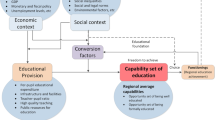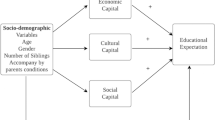Abstract
Higher education plays a significant role in economic growth and social development. However, the uneven development of higher education in China has become an important factor restricting its overall progress. Traditional data envelopment analysis (DEA) models used by previous studies are deterministic and susceptible to the impacts of measurement errors and the omission of unobserved but potentially relevant variables, which we referred to as environmental variables latter. To address both of these drawbacks, we develop and implement a three-stage DEA model to examine the efficiency of China’s mainland 31 provinces’ Higher Education Institutions (HEIs) in 2016, which fills the gap in the efficiency evaluation of HEIs in all provinces of China. The “real” efficiency about management performance of each province’s HEIs is obtained and decomposed after the impacts of environmental variables and random errors are eliminated. Lastly, relevant policy suggestions are given on how to improve the efficiency of each province’s HEIs.

Similar content being viewed by others
References
Abbott, M., & Doucouliagos, C. (2003). The efficiency of Australian universities: A data envelopment analysis. Economics of Education Review,22(1), 89–97.
Aigner, D., Lovell, C. K., & Schmidt, P. (1977). Formulation and estimation of stochastic frontier production function models. Journal of Econometrics,6(1), 21–37.
Anderson, T. R., Daim, T. U., & Lavoie, F. F. (2007). Measuring the efficiency of university technology transfer. Technovation,27(5), 306–318.
Banker, R. D., Charnes, A., & Cooper, W. W. (1984). Some models for estimating technical and scale inefficiencies in data envelopment analysis. Management Science,30(9), 1078–1092.
Banker, R. D., & Natarajan, R. (2008). Evaluating contextual variables affecting productivity using data envelopment analysis. Operations Research,56(1), 48–58.
Charnes, A., & Cooper, W. W. (1984). Preface to topics in data envelopment analysis. Annals of Operations Research,2(1), 59–94.
Charnes, A., Cooper, W. W., & Rhodes, E. (1978). Measuring efficiency of decision-making units. European Journal of Operational Research,2, 429–444.
Chen, Y., Liu, B., Shen, Y., & Wang, X. (2016). The energy efficiency of China’s regional construction industry based on the three-stage DEA model and the DEA-DA model. KSCE Journal of Civil Engineering,20(1), 34–47.
Cheng, Z., & Sun, G. (2008). A Study on the Efficiency of Chinese Universities. China Economic Quarterly,7(3), 1079–1104.
Cooper, W. W., Seiford, L. M., & Zhu, J. (2004). Data envelopment analysis. Handbook on data envelopment analysis. International Series in Operations Research & Management Science,71, 1–39.
Fare, R., Färe, R., Fèare, R., Grosskopf, S., & Lovell, C. K. (1994). Production frontiers. Cambridge: Cambridge University Press.
Feng, Y. J., Lu, H., & Bi, K. (2004). An AHP/DEA method for measurement of the efficiency of R&D management activities in universities. International Transactions in Operational Research,11(2), 181–191.
Fried, H. O., Lovell, C. K., Schmidt, S. S., & Yaisawarng, S. (2002). Accounting for environmental effects and statistical noise in data envelopment analysis. Journal of Productivity Analysis,17(1–2), 157–174.
Fuentes, R., Fuster, B., & Lillo-Bañuls, A. (2016). A three-stage DEA model to evaluate learning-teaching technical efficiency: Key performance indicators and contextual variables. Expert Systems with Applications,48, 89–99.
Izadi, H., Johnes, G., Oskrochi, R., & Crouchley, R. (2002). Stochastic frontier estimation of a CES cost function: The case of higher education in Britain. Economics of Education Review,21(1), 63–71.
Johnes, G., Johnes, J., Thanassoulis, E., Lenton, P., & Emrouznejad, A. (2005). An exploratory analysis of the cost structure of higher education in England. London: UK Department for Education and Skills.
Johnes, J. (2006a). Data envelopment analysis and its application to the measurement of efficiency in higher education. Economics of Education Review,25(3), 273–288.
Johnes, J. (2006b). Measuring efficiency: A comparison of multilevel modelling and data envelopment analysis in the context of higher education. Bulletin of Economic Research,58(2), 75–104.
Johnes, J., & Taylor, J. (1990). Performance Indicators in Higher Education: UK Universities (Society for Research into Higher Education). Buckingham: Open University Press.
Jondrow, J., Lovell, C. K., Materov, I. S., & Schmidt, P. (1982). On the estimation of technical inefficiency in the stochastic frontier production function model. Journal of Econometrics,19(2–3), 233–238.
Kao, C., & Hung, H. T. (2008). Efficiency analysis of university departments: An empirical study. Omega,36(4), 653–664.
Kempkes, G., & Pohl, C. (2010). The efficiency of German universities–some evidence from nonparametric and parametric methods. Applied Economics,42(16), 2063–2079.
Li, K., & Lin, B. (2016). Impact of energy conservation policies on the green productivity in China’s manufacturing sector: Evidence from a three-stage DEA model. Applied Energy,168, 351–363.
Meeusen, W., & van Den Broeck, J. (1977). Efficiency estimation from Cobb–Douglas production functions with composed error. International Economic Review,18, 435–444.
Nazarko, J., & Šaparauskas, J. (2014). Application of DEA method in efficiency evaluation of public higher education institutions. Technological and Economic Development of Economy,20(1), 25–44.
Ng, Y. C., & Li, S. K. (2009). Efficiency and productivity growth in Chinese universities during the post-reform period. China Economic Review,20(2), 183–192.
Shyu, J., & Chiang, T. (2012). Measuring the true managerial efficiency of bank branches in Taiwan: A three-stage DEA analysis. Expert Systems with Applications,39(13), 11494–11502.
Simar, L., & Wilson, P. W. (2007). Estimation and inference in two-stage, semi-parametric models of production processes. Journal of Econometrics,136(1), 31–64.
Stevens, P. A. (2005). A stochastic frontier analysis of English and Welsh universities. Education Economics,13(4), 355–374.
Wang, X., & Hu, H. (2017). Sustainable evaluation of social science research in higher education institutions based on data envelopment analysis. Sustainability,9(4), 644.
Witte, K. D., & López-Torres, L. (2017). Efficiency in education: A review of literature and a way forward. Journal of the Operational Research Society,68(4), 339–363.
Wolszczak-Derlacz, J., & Parteka, A. (2011). Efficiency of European public higher education institutions: A two-stage multicountry approach. Scientometrics,89(3), 887.
Zeng, S., Hu, M., & Su, B. (2016). Research on investment efficiency and policy recommendations for the culture industry of China based on a three-stage DEA. Sustainability,8(4), 324.
Zhang, J., Liu, Y., Chang, Y., & Zhang, L. (2017). Industrial eco-efficiency in China: A provincial quantification using three-stage data envelopment analysis. Journal of Cleaner Production,143, 238–249.
Funding
Funding was provided by National Natural Science Foundation of China (Grant Nos. 71571173, 71701059, 71904084). Natural Science Foundation for Jiangsu Institutions (No. BK20190427), Social Science Foundation of Jiangsu Institutions (No. 19GLC017), the Fundamental Research Funds for the Central Universities (Nos.1Z2019HGTB0095, No. XAB19005).
Author information
Authors and Affiliations
Corresponding author
Ethics declarations
Conflict of interest
The authors declare that they have no conflict of interest.
Rights and permissions
About this article
Cite this article
Wu, J., Zhang, G., Zhu, Q. et al. An efficiency analysis of higher education institutions in China from a regional perspective considering the external environmental impact. Scientometrics 122, 57–70 (2020). https://doi.org/10.1007/s11192-019-03296-5
Received:
Published:
Issue Date:
DOI: https://doi.org/10.1007/s11192-019-03296-5




